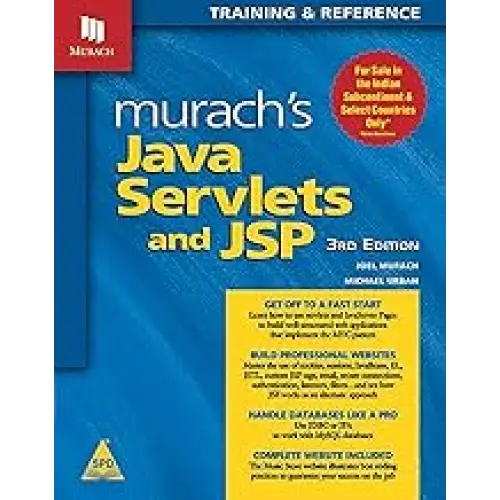BOOKZONE
Murach's Java Servlets and JSP, 3rd Edition
Paperback
by Joel Murach
SKU:9789352133253
Bulk Discount Get Exta 5% upto 10%
Share

Who this book is for
This book is for anyone who wants to develop professional websites using Java servlets and JSPs. The only prerequisite is a basic understanding of the Java programming language, roughly equivalent to chapters 1 through 14 of our core Java book, Murach’s Java Programming. But you don’t need any web programming experience at all.
What you’ll learn in this book
Section 1: Get started right
In this section, you’ll learn:
- the concepts and terms that you need for Java web programming
- how to use the MVC pattern to get the most from JSPs and servlets
- how to use the NetBeans IDE for developing servlet and JSP applications more efficiently
- how to use the Tomcat web server that lets you use servlets and JSPs for web applications
By the time you’re through with this section, you’ll be ready to use the IDE to code and run servlets and JSPs on your own computer.
Section 2: The essential servlet and JSP skills
In this section, you’ll get a crash course in HTML and CSS, which are essential to the use of JSPs. Then, you’ll learn the skills for creating servlets and JSPs that you’ll use in almost every application. These chapters move from the simple to the complex as you learn how to work with servlets, JSPs, sessions, cookies, JavaBeans, Expression Language (EL), the JSP Standard Tag Library (JSTL), and custom JSP tags.
Section 3: The essential database skills
Here, you’ll learn how to use both JDBC (Java Database Connectivity) and JPA (Java Persistence API) to work with a database. Although this section focuses on the use of MySQL databases, JDBC and JPA can be used for working with any database management system, including Oracle and SQL Server.
Section 4: Advanced servlet and JSP skills
In this section, you’ll learn the advanced servlet and JSP skills that you will need for certain types of web applications. This includes the use of JavaMail, SSL, authentication, encryption, HTTP, listeners, and filters. Then, the last chapter in this section shows you how to use JavaServer Faces, which is an alternative to using JSPs.
Since the chapters in this section have been designed to work independently of each other, you can read them in any order you want. This makes it easy for you to learn new skills whenever you need them.
Section 5: The Music Store website
This section presents an e-commerce website that puts the skills in the first four sections into context. This downloadable application illustrates best practices and provides code that you can use in your own applications. Once you understand how this website works, you will have all the skills you need for creating your own web applications.


